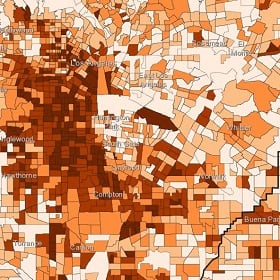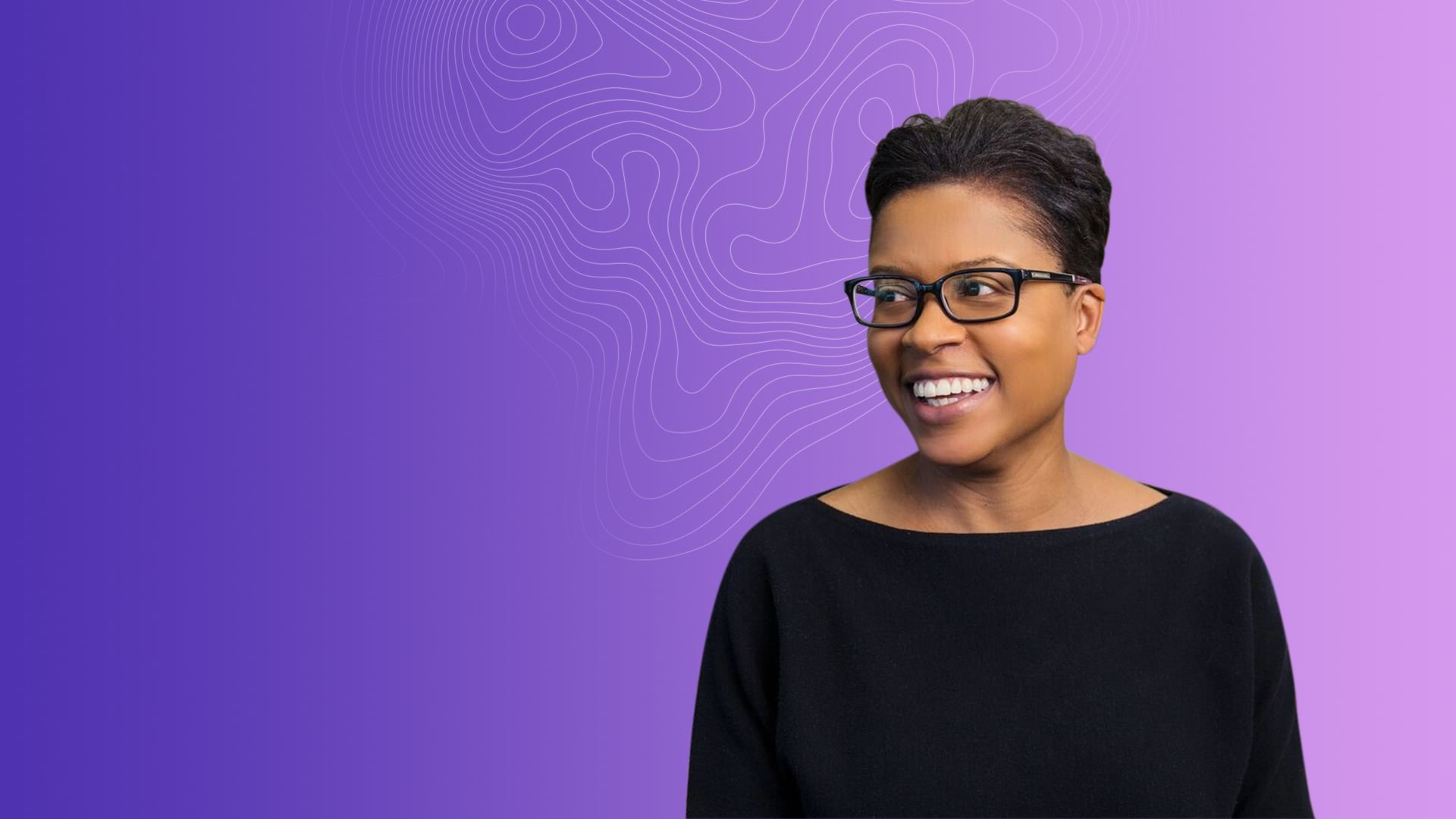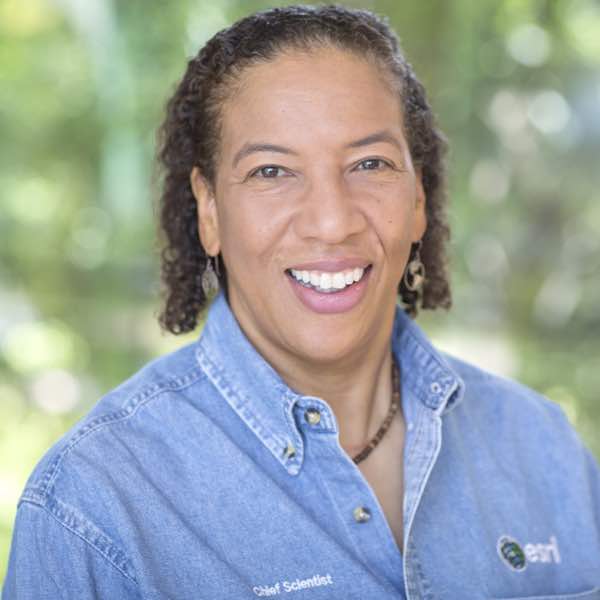Paulette Brown-Hinds, publisher of Black Voice News in California, views location intelligence as key to producing deeply researched articles to inform the public, empower the voiceless, and spur social change. Her staff of writers and editors uses geographic information system (GIS) technology to uncover location intelligence and share it with readers in communities of color.
“When I saw the possibilities and potential for this GIS tool, I just started reading as much as I could,” Brown-Hinds says. “It’s not just a tool for community media, but I saw it through a kind of a community-building and a community-engagement lens.”
Through her family’s Black Voice Foundation, Brown-Hinds also shares GIS strategies with other news outlets and promotes location intelligence as a valuable job skill for minority students (see sidebar).
Community Advocacy in a Time of Need
Black Voice News recently won a $100,000 award from Facebook to add or train employees in GIS, with the goal of continuing the newspaper’s coverage of COVID-19 news and information.
The effort advances an increasingly popular form of journalism—one that uses data and map-based visuals to enrich and enliven stories. In one recent example, a Black Voice News story featured a GIS analysis of COVID-19 incidence throughout California, cross-referenced with the prevalence of negative health factors in each area. The maps fulfill a core tenet of journalism—to equip citizens with information that helps them make educated choices.
For Brown-Hinds, there’s a deeper mission at play—a centuries-long tradition of service and advocacy among the black press.
“Our history is rooted in the demand for freedom and justice,” she says. “We’ve always seen ourselves as serving as a public defender of the civil and human rights of our community.”
Such journalism complements a nationwide movement among individuals and businesses toward equity and inclusion. Following global protests spurred by the police killing of George Floyd and other people of color, businesses have pledged to strengthen their corporate social responsibility initiatives, including those aimed at bolstering equity and inclusion. Local newspapers like Black Voice News have raised that issue for decades, often through maps that expose stark imbalances.
In Brown-Hinds’s telling, newspapers like the Black Voice News “have a duty to plead the cause of our communities. We also have a duty to give voice to the voiceless [and] keep a vigilant eye on those who have sworn to work for the public good.”
To encourage more-accurate Census counts, Brown-Hinds and team rely on data and storytelling to power a Mapping Black California campaign. For instance, they have created GIS-based maps that highlight areas of California at greatest risk of being undercounted. The data layers of one map reveal statistics on each county, including poverty rates, response rates for the last census, internet access, and a demographic breakdown. Armed with this information, residents and businesses in the area can amplify the importance of census participation in gaining local representation and resources.
The recent funding infusion will boost her team’s efforts.
“The grant will allow us to hire a journalist with GIS skills to produce additional COVID-19 stories and consult with our team to help them create more story maps and data visualizations,” says Brown-Hinds, who recently served as the first African American to head the 130-year-old California News Publishers Association. “There is a focus on sustainability, so we are also able to hire a consultant to work with me on building a business model with more diverse revenue streams.”
Business Model Rooted in Advocacy Helps US Census Find Hard-to-Count Populations
Advocacy and community engagement also helped the consulting arm of Brown-Hinds’s communications group win a contract to help California’s Census office reach hard-to-count communities.
Minority populations have often been difficult to count. Many do not have strong trust in government and hesitate to answer census questions. But if residents don’t stand up to be counted, lower-than-actual population tallies can mean fewer federal funds to meet the needs of their community.
Brown-Hinds and team have also partnered with black-owned media outlets—from local newspapers to a radio station owned by Stevie Wonder—to promote the census and motivate the black community to be counted.
It’s an example of how advocacy can bolster residents’ faith in a community-focused messenger like Black Voice News.
“This has been a substantial contract for our small team,” Brown-Hinds tells WhereNext. “With this, we are also trying to show other media outlets how they can move into the digital world, although they’re having to do it faster than they ever imagined because of the economic stress of the [COVID-19] pandemic.”
Family Tradition of Community Engagement
The idea of corporate social responsibility seems to come alive in the companies led by Brown-Hinds and her family members. That’s probably because the family is continuing a proud legacy of community engagement.
“Oftentimes we’re telling the stories of the voiceless and those who have no power—the underrepresented. I feel that that’s one of the reasons that I’m here,” Brown-Hinds says.
Brown-Hinds is proud of her family’s tradition of social justice.
Her grandfather risked his life to register voters in North Carolina. Her mother—Cheryl Brown—served as a member of the California State Assembly and is currently on the California Commission on Aging. Her father, Hardy, left his sharecropper’s life in North Carolina to become a community leader in Southern California, eventually becoming the first African American to serve as president of his local school board. He later founded California Black Media to help minority news outlets support each other.
Brown-Hinds, who earned a doctorate in African American literature and culture from the University of California–Riverside, has expanded and modernized her family’s efforts, in part by exploring digital technologies like GIS that help for-profit and nonprofit organizations advocate for the historically voiceless.
A Newspaper Founded in Advocacy
Black Voice News was started by students at UC-Riverside in 1972. In 1980, it was purchased by Hardy and Cheryl Brown, who kept alive its sense of advocacy as a voice for the black community. Their daughter, Paulette, assumed control in 2013.
Her efforts to use GIS and location intelligence to produce data-rich projects have earned the praise of Neil Chase, former executive editor of The Mercury News and current CEO of CalMatters, a nonpartisan, nonprofit journalism venture that covers politics and the effect of policy making in California state government.
In addition to praising her work on Mapping Black California and Segregation by the Sea and her interest in showing smaller news outlets the benefits of digital data and GIS-based analysis, Chase says he is amazed by how Brown-Hinds’s work has brought her in contact with many in California journalism, politics, and foundations.
“She’s one of those people you come across everywhere you go in California,” Chase says. “Everybody knows her. Everybody asks if you know her. And she’s one of these people who, by the time you get done having a conversation with her, will have suggested two other people you should talk to and made an introduction to one of them.”
Brown-Hinds attributes her relentless motion and diverse business pursuits to her childhood.
“My husband says if I take one thing off my plate, I’m going to add two more. It’s just the way I was raised,” she says. “You never really sat, and you could never say you were bored. You just always had to be doing something.”
Mindful of that energy and Brown-Hinds’s wide-ranging knowledge of issues and people, Chase asked her to serve on the board of CalMatters. “She gets stuff done,” Chase says. “She just seems to sort of step in and do things and not spend a lot of time worrying about it.”
She also has begun to think about how GIS-powered location intelligence might help smaller news outlets pinpoint potential subscribers and help advertisers connect with the reader base. Some newspaper and media groups such as Star Tribune Media Company in Minneapolis even share location intelligence with potential advertisers to help them formulate marketing strategies.

Maps and location intelligence and understanding where you are and the importance of place—especially in African American culture—has been foundational.
Promoting Location Intelligence as a Career Path
Andre Loftis was a graphics artist who got to know Brown-Hinds while both were volunteering to help at-risk students. Soon he joined her staff and took part in the family’s nonprofit history tours, which takes participants along a probable route of the Underground Railroad.
Although Loftis knew a lot about his heritage, he felt transformed by the experience of standing beside remnants of safe houses and walking up steep paths in the footsteps of people who escaped bondage. “It gave me more appreciation for the people who risked their lives to find freedom or to abolish slavery,” he says. “When you finish that trip, the idea of civil service and helping your fellow man really stays with you.”
Afterward, Brown-Hinds asked him to create a story map of the trip, and he became fascinated by the power of location intelligence and the flexibility of GIS technology. When he got involved in the Mapping Black California project, Loftis saw the potential for GIS analysis and visualization to complement many social justice causes, so he decided to go back to school to learn more.
Today, he works for the California Department of Consumer Affairs, where he uses mapping and location intelligence to uncover patterns of fraud that take advantage of those with little power to fight back.
He recalls Brown-Hinds’ leadership style as a mix of casual and demanding—a person who speaks plainly without putting on airs, and someone who expects results. He also saw the perpetual motion that propels her to broaden her company’s portfolio. “Big things begin when it seems like we’re just having a conversation,” Loftis says. “But she’s really trying to gauge people’s interest in something she wants to launch.”
He appreciated her willingness to delegate. “She’s not over your shoulder reminding you all the time that she’s the boss. She doesn’t micromanage. She’s just like, ‘I recognize your skills, and I trust your skill set. I’m going to provide feedback, and let’s get this done.’”
Loftis says he always saw Brown-Hinds invest her energy wisely. “She’s passionate about how her work affects the community, but she’s resourceful. I think she’s always worked so hard because she wants to make sure she’s making a difference in her community.”
A Practical-Minded Visionary
Stephanie Williams, managing editor of Black Voice News, came to journalism later in life after nearly 30 years at AT&T, often working in employee retention. When she retired from that career, she found a small newspaper and received on-the-job training as a news writer and editor. It was a good job, but it often felt repetitive. When she crossed paths with Brown-Hinds, she saw a person who looked to the horizon and drew maps to get there.
“She’s definitely an inspiration,” Williams says. “I’m 70 and I still feel excited about what’s on the horizon, just because I see the efforts that she’s putting into moving us as an organization into the future. But not only us, because she’s setting an example for other members of the black media in California.
That work has taken on new urgency in the wake of George Floyd’s death and subsequent demands for change. Brown-Hinds and the Black Voice News team plan to use data and location intelligence to illuminate the factors in play.
That might include publishing dashboards showing the percentage of municipal budgets allocated to law enforcement. With GIS technology, she says, journalists can view that data by city, with associated population data by race. That might identify situations where heavy policing tactics could be mitigated by budget allocations that instead provide services and resources for communities in need.
“It’s not just about the poverty index,” she notes. “It’s about the type of amenities that make a community livable and thriving.”
Williams admires Brown-Hinds’s gift for creating better communities through journalism and says she appreciates the nimble mind and never-say-quit approach to problems that Brown-Hinds displays.
“She just says, ’If this door closes, what’s another avenue? Let’s just turn a different direction. We’ll get this done. We just have to raise our level of thinking to find a solution.’”
For the communities that rely on Black Voice News, Brown-Hinds believes those solutions should be rooted in data-based analysis, rich storytelling, and a sense of place.
“Oftentimes we’re telling the stories that other people wouldn’t tell,” she says. “I feel like that’s why I’ve been put here. And also why I am exposed to things like this technology that I think help us [tell stories] even better.”
Photo credit: Daley Hake
The Esri Brief
Trending insights from WhereNext and other leading publicationsTrending articles

December 5, 2024 |

July 25, 2023 |

April 1, 2025 |

November 12, 2018 |

April 16, 2024 |

February 1, 2022 |





